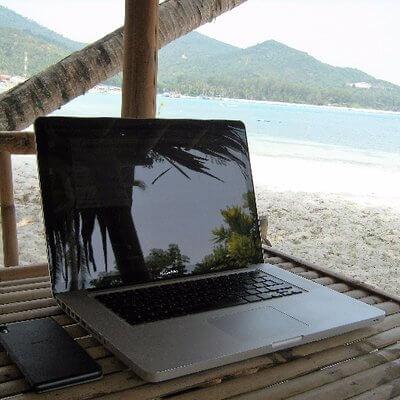How do you stay in touch with virtual teammates?
Microsoft Lync sessions and emails.
We Slack pretty much all day long with questions and updates. I honestly feel we communicate more and more quickly than I did in an office setting.
I don’t tend to have teammates (as I work on my own) but I stay in touch with my clients via Slack, Skype, and email. Slack is useful for collaborating with a few people but I also try and limit usage as otherwise you can end up spending the whole day bouncing ideas back and forth rather than actually working on the project.
We use Google Hangouts and GoToMeeting. I’ll have my webcam on for nearly every meeting as do most of my teammates. It’s important because it adds a personal touch to the virtual meeting.
I co-founded a publishing company with some friends, but a lot of the time we’re all dealing with our own facets of the business, and as such don’t have to be in contact all that much. We chat via email and text sometimes, but we don’t speak to each other every day, or even every week. That would be majorly distracting, I think.
I actively use Skype for quick chats, as well as the Citrix GoToMeeting, as well as Dialpad’s Uber conference (free basic!). I have a T-Mobile plan that allows free calls in 200+ countries!
Email, Slack, passing files between Sharepoint, text messaging.
Mostly via Skype, email, and the Gmail chat thingy. It’s good to have real conversations (via Skype or just the phone) with people. I think things can get a bit “cold” if all you do is communicate via email. It’s nice to at least hear each other’s voices here and there.
I’ve learned how important it is to be able to convey your personality digitally and be an excellent chat communicator. You basically have to rediscover your personality in the form of shorthand expressive chat, emoticons, and video calls! It’s different, but can be just as fun as IRL.

We instant message all the time. I also have specific 30-minute one-to-one calls with all my key teammates. I have a rule—never show “do not disturb,” as that’s like having a closed office and that’s not our culture. So I do “virtual open door” by always being ready to respond to an IM. Strangely, I don’t really do video calls. After so many years, just hearing people is good enough. I’ve noticed I’ve become really perceptive. I know who is breathing ready to ask a question when I have 10 colleagues on a call, for example.
Mostly email and Gchat, although I suspect that Slack et. al. will soon eclipse both.
We use Slack to communicate at GitHub and have a lot of practical channels: ones that are team-specific, or those that focus on affinity groups like women or parents. We also have Slack channels that are just for fun, like the #cat-ops channel, where people post pictures and stories about cats. When you work remotely, you miss out on the random conversations that bond people so it’s important to find other ways to have those moments; sometimes that comes in the form of sharing a picture of your cat sleeping in the sun.
I feel more connected to my teammates working remotely than I did when we were all in an office. I make more of an effort to get to know them personally because I don’t see the pictures in their office, or overhear a conversation in the breakroom. We use Skype, and I talk on the phone many times throughout the day so I always feel like they are at my fingertips. We also follow each other on social media and try many get-to-know-you type icebreakers on our calls. We even go visit each other in different cities when we can!
Using a combination of Trello comments, Dropbox notes, and bi-weekly calls.
We use Slack and Asana to manage our workflow, and often speak on Skype or phone at least 2-3 times per day.
I am on the phone most of the day, as most of my team is not located in the same city as I am. I have biweekly one-on-one meetings with my direct reports and a biweekly leadership team meeting, sometimes in person and sometimes on the phone. I also do video conferences with my team once a month to further personalize employee engagement and ensure they get face time with their colleagues. Email and instant messaging are essential for continual communication. I come into the office a couple of days each week, and sometimes see or talk to people who are offsite more than I see the people down the hall!
We use Slack as a company. My team uses Google hangout to see each other every other week. In weekly one-on-one meetings, we use Google Hangouts or voice calls. Every team is different. Then we have team meetups in person twice a year; we have a company meetup once a year. Colleagues also meet each other at conferences or WordCamps throughout the year.
Skype for Business is a key tool, as well as WhatsApp on my smart phone to stay in touch with coworkers outside of the country.
I make an effort to instant message my teammates on a daily basis, rotating through teammates throughout the week to socialize. Often times during a shared conference call, I will instant message them to share my reaction and gather insight on their point of view.
My virtual team has different ways for being in touch. For asynchronous communication we use Slack. We also meet several times a week using my favorite video conferencing tool, Zoom: there are a couple of team meetings, one company meeting, and one meeting just for hanging out together (we call it “kitten talk”). To know what each other are working on, we use a combination of iDoneThis and Trello. For those that become close personal friends, we also connect on WhatsApp and social media.
Skype, Google Hangouts, and email. We can’t say enough good things about video conferencing.
Google Hangouts, HipChat (similar to Slack), email, and, if we really can’t find each other, cell phone!
To stay in touch with virtual teammates, I use Skype, Trello, and Slack to communicate and update tasks.
I use shared Google Calendar to track deadlines for clients and my freelance team. Then, we organize tasks and projects on dedicated boards in Trello. I switched to this system a few years ago, after trying to stay low-key using emails and such, and Trello revolutionized my ability to keep track of every aspect of current projects, both personal and professional.
I don’t have teammates in the traditional sense. I do, however, have colleagues who are also freelancers. We usually email or meet up for coffee every so often.
Because magazine work is so cyclical, I don’t necessarily have to be in touch with all my colleagues on a daily basis, which is to say we don’t need to use Slack or any of the other fancy collaboration tools. We use Dropbox, Gchat, and phones.
Email and cell phone; VoIP for overseas co-workers.


























